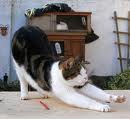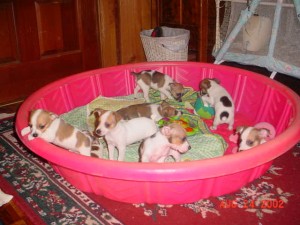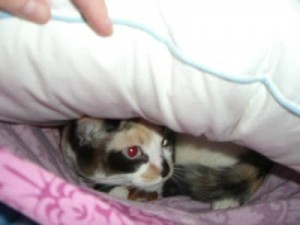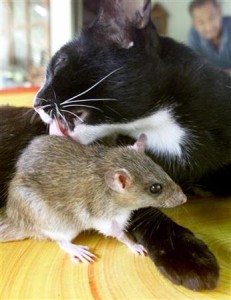Archive for November, 2011
Feeding time in a multi cat household
 We know that cats are territorial by nature and will develop a top cat, bottom cat structure. In my home, my older cat Mollie is the top cat and my younger cat, Millie is the bottom cat. This is hard on the more timid ones like Millie. Without sufficient space and privacy, they could become stressed out. There is one way that you could reduce the stress in your multi-cat household. You should give each cat it’s own food dish and water bowl.. If different bowls don’t work for you, you could feed your cats on wide trays or baking sheets. You could set up separate feeding stations or even feed problem cats in separate rooms. All of these strategies will make for a more peaceful household. It will also give some more room for timid cats like my Millie.
We know that cats are territorial by nature and will develop a top cat, bottom cat structure. In my home, my older cat Mollie is the top cat and my younger cat, Millie is the bottom cat. This is hard on the more timid ones like Millie. Without sufficient space and privacy, they could become stressed out. There is one way that you could reduce the stress in your multi-cat household. You should give each cat it’s own food dish and water bowl.. If different bowls don’t work for you, you could feed your cats on wide trays or baking sheets. You could set up separate feeding stations or even feed problem cats in separate rooms. All of these strategies will make for a more peaceful household. It will also give some more room for timid cats like my Millie.
Remember, your pets count!
How to keep your small dog safe
 A small dog is more at risk than a large one, especially at dog parks, dog runs and even at doggie daycare. It’s up to you to keep your little dog protected. There are several steps that you could take to do so. When choosing a dog day care facility, choose a place where dogs are screened for good social skills and lack of aggressive tendencies. If the big dogs and small dogs are kept in separate areas, your dog will be much less at risk. Make sure that you are very vigilant at the dog park. An irresponsible owner can show up anytime with an overly excited or badly behaved dog.
A small dog is more at risk than a large one, especially at dog parks, dog runs and even at doggie daycare. It’s up to you to keep your little dog protected. There are several steps that you could take to do so. When choosing a dog day care facility, choose a place where dogs are screened for good social skills and lack of aggressive tendencies. If the big dogs and small dogs are kept in separate areas, your dog will be much less at risk. Make sure that you are very vigilant at the dog park. An irresponsible owner can show up anytime with an overly excited or badly behaved dog.
I once had my small dog in the park on his lease and the very irresponsible dog owner let his large dog in the park without a leash. The dog charged toward me and my little dog, knocked me over and had my little dog in it’s mouth. After I got up and charged at him, the he my little dog. Luckily my little dog got away with some cuts, although he was very tramatized. I think of that horrible day from time to time and still can’t believe how people could be so stupid and not use any common sense! My advice would be to look for a park with a separate area set aside for small days to play safely.
Remember, your pets count!
Cat colds
 When your cat is sneezing and has a runny nose, we assume that it’s a cold. It’s not the same kind of cold that we get. It’s really an upper respiratory infection. In cats, respiratory problems are caused by a complex network of bacteria and viruses that are found in our environment. All cats have been exposed to these pathogens at birth. If your cat has chronic sinusitis and conjunctivitis, it could be caused by the Feline Herpes virus.
When your cat is sneezing and has a runny nose, we assume that it’s a cold. It’s not the same kind of cold that we get. It’s really an upper respiratory infection. In cats, respiratory problems are caused by a complex network of bacteria and viruses that are found in our environment. All cats have been exposed to these pathogens at birth. If your cat has chronic sinusitis and conjunctivitis, it could be caused by the Feline Herpes virus.
So when should you seek the advice of your veterinarian? Usually a cat cold or respiratory infection has to run it’s course just like it does in humans. Don’t administer any pet medication without the advice of your vet. Seek advice if there is a yellow or green discharge in the eyes or nose or if your cat becomes lethargic or stops eating. Some cats may need antibiotics to combat these infections. In more severe cases,it’s possible for your cat to develop fevers or pneumonia. Let your veterinarian make the final diagnosis.
Remember, your pets count!
Getting a second dog
 Are you thinking of getting a second dog? There are several important considerations that you’re probably aware of, but size is rarely one of them. A large breed dog and a small breed dog can happily live together as long as your larger dog is not too rough when he plays. More important than size is the sex of the two pets. If you have a male dog, look for a female as a second dog and vice versa. Two females sometimes don’t get along well and two males may get into it over pack position. Opposite sex dogs are most likely to get along well. The most important thing to remember is that your first dog is very well socialized and well behaved before you introduce a second dog into your household. If he’s anxious, or barks a lot, he could easily teach your second dog the same bad habits.
Are you thinking of getting a second dog? There are several important considerations that you’re probably aware of, but size is rarely one of them. A large breed dog and a small breed dog can happily live together as long as your larger dog is not too rough when he plays. More important than size is the sex of the two pets. If you have a male dog, look for a female as a second dog and vice versa. Two females sometimes don’t get along well and two males may get into it over pack position. Opposite sex dogs are most likely to get along well. The most important thing to remember is that your first dog is very well socialized and well behaved before you introduce a second dog into your household. If he’s anxious, or barks a lot, he could easily teach your second dog the same bad habits.
Remember, your pets count!
Hearing loss in older cats
 If you have an older cat and she ignores you when you call her, she may not just being stubborn, she may not have heard you. As with humans, hearing in cat decreases gradually with age. Cats can compensate so well that their owners may not realize that there is a problem until the cat is completely deaf. Look for disorientation, loud meowing and a startled response when touched from behind. Hearing loss due to aging can’t be cured, but deaf cats can still sense vibration. Tap your fingers next to your cat before stroking him to alert him to your presence. Never let a hearing impaired cat outdoors. Ear mites, infections and tumors can also impair hearing. If you suspect hearing loss in your cat, check with your veterinarian.
If you have an older cat and she ignores you when you call her, she may not just being stubborn, she may not have heard you. As with humans, hearing in cat decreases gradually with age. Cats can compensate so well that their owners may not realize that there is a problem until the cat is completely deaf. Look for disorientation, loud meowing and a startled response when touched from behind. Hearing loss due to aging can’t be cured, but deaf cats can still sense vibration. Tap your fingers next to your cat before stroking him to alert him to your presence. Never let a hearing impaired cat outdoors. Ear mites, infections and tumors can also impair hearing. If you suspect hearing loss in your cat, check with your veterinarian.
Remember, your pets count!
Tapeworms
 Tapeworms are intestinal parasites that attach to a cat or a dog’s small intestine. Here, they can grow several inches long. As they mature, mobile segments which resemble grains of rice break off and pass into the stool. Most owners first notice them crawling on a dog or cat’s anus or are seen in the animals stool. As the tapeworm segments dry, they break open and release the eggs inside. Flea larvae then feed on these tapeworm eggs. When dogs or cats lick their skin, they may swallow an infected flea. Once swallowed, the tapeworm hooks onto the pets intestine completing the life cycle. To get rid of tapeworms talk to your veterinarian as soon as possible.
Tapeworms are intestinal parasites that attach to a cat or a dog’s small intestine. Here, they can grow several inches long. As they mature, mobile segments which resemble grains of rice break off and pass into the stool. Most owners first notice them crawling on a dog or cat’s anus or are seen in the animals stool. As the tapeworm segments dry, they break open and release the eggs inside. Flea larvae then feed on these tapeworm eggs. When dogs or cats lick their skin, they may swallow an infected flea. Once swallowed, the tapeworm hooks onto the pets intestine completing the life cycle. To get rid of tapeworms talk to your veterinarian as soon as possible.
Remember, your pets count!
Weening your puppy
 Weening is the process of teaching a puppy to eat solid food instead of it’s mother’s milk. When they are first born, puppies get all of their nutrition from their mother’s milk. As they get older, they require more nourishment then she can provide. Most veterinarians recommend that puppies be weened sometime between three and seven weeks of age. Switching from their mother’s milk to dry puppy food is a big change. Help your puppy ease into his new diet slowly. The first thing that you should do is crush a small amount of puppy food and mix it with milk so that the consistency is thin. Use less and less liquid over the next several weeks so that the food becomes thicker. By week seven, the puppy should be able to eat dry puppy food. You can even start to give him a small amount of dog treats.
Weening is the process of teaching a puppy to eat solid food instead of it’s mother’s milk. When they are first born, puppies get all of their nutrition from their mother’s milk. As they get older, they require more nourishment then she can provide. Most veterinarians recommend that puppies be weened sometime between three and seven weeks of age. Switching from their mother’s milk to dry puppy food is a big change. Help your puppy ease into his new diet slowly. The first thing that you should do is crush a small amount of puppy food and mix it with milk so that the consistency is thin. Use less and less liquid over the next several weeks so that the food becomes thicker. By week seven, the puppy should be able to eat dry puppy food. You can even start to give him a small amount of dog treats.
Remember, your pets count!
Mixed breed cats
 There are numerous names for a dog that is a mixed breed. Mutt is one of them. The name for a mixed breed cat sounds a bit more sophisticated, the domestic short hair or the domestic long hair. These cats make great companions and have a healthy mixture of genes which usually keeps them free of most diseases. Their personality and friendliness is hard to predict from kitten hood, since they don’t breed true like the pure breeds. The domestic short hair and domestic long hair rank first and second in popularity among all domesticated cats. They are also easier to obtain, and they are a great choice for first time cat owners.
There are numerous names for a dog that is a mixed breed. Mutt is one of them. The name for a mixed breed cat sounds a bit more sophisticated, the domestic short hair or the domestic long hair. These cats make great companions and have a healthy mixture of genes which usually keeps them free of most diseases. Their personality and friendliness is hard to predict from kitten hood, since they don’t breed true like the pure breeds. The domestic short hair and domestic long hair rank first and second in popularity among all domesticated cats. They are also easier to obtain, and they are a great choice for first time cat owners.
Remember,give them a good comfortable cat bed, lots of treats and love and they will be with you for a long time.
Your pets count!
Your cats body language
 Cats may be considered quite cryptic but others know that it’s their body language that tells the inside story. If you observe their tails you’ll get know your cats moods. Their mood can be revealed through their tail’s position, movement and hair posture. An upright and bristled out tail usually means aggression. The same upright tail with flatted hair, indicates a friendly greeting. If she is swishing her tail side to side, this means that she is angry. If her tail is tucked between her legs, she is afraid. Other parts of the body such as ears, eyes and legs are also indicators of your cats mood. If you take the time to understand your cats body language, you’ll be rewarded by a stronger bond and better communication.
Cats may be considered quite cryptic but others know that it’s their body language that tells the inside story. If you observe their tails you’ll get know your cats moods. Their mood can be revealed through their tail’s position, movement and hair posture. An upright and bristled out tail usually means aggression. The same upright tail with flatted hair, indicates a friendly greeting. If she is swishing her tail side to side, this means that she is angry. If her tail is tucked between her legs, she is afraid. Other parts of the body such as ears, eyes and legs are also indicators of your cats mood. If you take the time to understand your cats body language, you’ll be rewarded by a stronger bond and better communication.
Remember, your pets count!
Cats keeping the mice away
 We’ve also heard the old adage “while the cat’s away, the mice will play.” The relationship between a cat and a mouse is iconic. If you don’t want a mouse in your house, get a cat who will be on patrol all the time. Even if your cat is not good a catching mice, her scent is usually enough to keep them away. If you have mice already, getting a cat won’t hurt but setting traps may be more effective. Your cat won’t be able to catch mice if they are in your walls. In this case, watch your pet food bowls since leftovers could be tempting to mice and other critters!
We’ve also heard the old adage “while the cat’s away, the mice will play.” The relationship between a cat and a mouse is iconic. If you don’t want a mouse in your house, get a cat who will be on patrol all the time. Even if your cat is not good a catching mice, her scent is usually enough to keep them away. If you have mice already, getting a cat won’t hurt but setting traps may be more effective. Your cat won’t be able to catch mice if they are in your walls. In this case, watch your pet food bowls since leftovers could be tempting to mice and other critters!
Remember, your pets count!